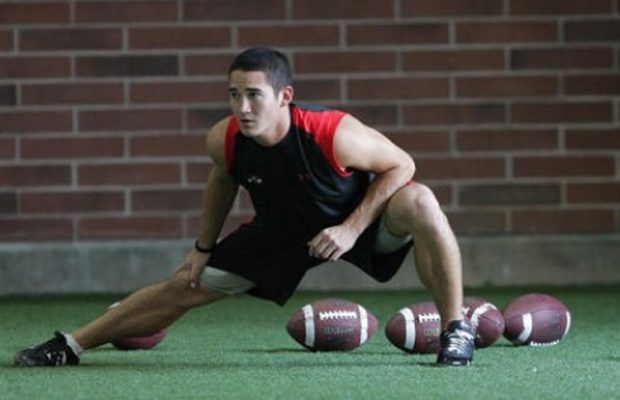Why Football Players Must Perform Movement Preparation Warm-Ups

It has become standard training knowledge: athletes must warm up before a practice, game or weightlifting session. But other than that, most conventional wisdom is wrong. Why? Because many football coaches and trainers still prescribe old-fashioned warm-ups, including static stretches and light movements (e.g., jogging or bicycling).
Football is all about intensity. Sprinting, tackling and throwing are all complicated movement patterns, which require an athlete’s body to work as a single integrated unit. So in order to get the most out of a training session, football players need to prepare specifically with functional movements. Think stability and mobility, the cornerstones of virtually every football movement. For example, when you sprint, one leg needs to balance (stability) while the other leg moves to its maximum range of motion (mobility) and the T-spine rotates.
Football players should perform movement-preparation warm-ups that consist only of stability and mobility exercises to prepare for athletic movements. For example, if a workout involves sprinting, perform a Dynamic Lunge with Rotation, which challenges single-leg stability, hip mobility and T-spine mobility.
Additional benefits of movement preparation warm-ups
Adequately prepare the body (and mind) for your workout, practice or game
Performing movements specific to your sport will not only result in better performance but will also improve your mental game. By focusing on movements, football players will zero in on the task at hand, which is especially helpful for those who tend to become distracted or nervous.
Example: Watch elite sprinters before a 100m race. It’s not unusual to see them at the track up to two hours before the event, beginning to prepare their bodies and revving their engines, so that when the race begins, everything is firing and ready to blast.
Improve and reinforce biomechanics and efficiency
Poor biomechanics force an athlete’s body to compensate and recruit muscles unnecessarily. If you perform repetitions with a compensatory movement pattern, your body will hardwire that movement pattern. (See Eliminate Muscle Imbalances to Improve Performance and Stay Injury-Free.) Such little mistakes may not hurt your performance immediately, but over time they will increase the likelihood of injury and ultimately prevent you from reaching your potential. By incorporating movement prep exercises and working on your weak links, you will move better and play better.
Example: Watch your favorite performers at the NFL Combine 40-Yard Dash. Everything looks fluid and smooth, yet “tight.”
Enhance endurance
Movement prep activates the core while increasing strength in functional movement patterns. That’s why Inchworms (i.e., Hand Walks) are among the most effective movement prep exercises for football.
Core and functional strength enable football players to generate more power for longer periods. This makes them better athletes, because they are able to maintain speed and power along with their other skills.
Tip: Your movement prep warm-up should be specific to what you will do that day. It should differ depending on whether you are planning speed work or upper body lifting. Remember, everything should have a purpose and fulfill a function.
Now that you understand the theory behind movement preparation warm-ups, it’s time to learn how to incorporate them into your training. Check back in the coming weeks as I provide warm-ups for every aspect of football training.
Sources
Verstegen, M. Core Performance. New York, NY: Rodale, 2007.
Cook, G and Taylor A. “Ready to Lift?” J Optimum Performance, Sept 2005.
Cook, G. Athletic Body in Balance. Champaign, Ill: Human Kinetics, 2003.
Boyle, M. Functional Training for Sports. Champaign, Ill: Human Kinetics, 2004.
Kiesel, K., Plisky, P.J., and Voight, M. L. “Can serious injury in professional football be predicted by a pre-season functional movement screen?” North American Journal of Sport Physical Therapy, 2(3), 147-158, 2007.
Magill, R. A. Motor Learning and Control: Concepts and Applications (9th ed.). New York: McGraw-Hill, 2011.
Photo Credit: Getty Images // Thinkstock